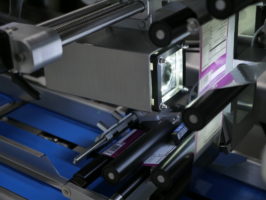Behind the scenes: Tackling key industry packaging hurdles

Branding Ideas Design Identity Marketing Concept
Every confectionery supplier is striving for brand recognition, and packaging plays a major role in achieving this goal. But it’s important to keep sight of the major hurdles resulting from SKU proliferation. Daisy Phillipson reports
Managing an increasing number of SKUs can be costly for confectionery producers, particularly when many of them only contribute to a small portion of their profit. According to PMMI’s Trends in Food Processing Operations, four out of five companies have more than 100 product SKUs and over half predict SKUs will continue to increase.
As outlined by Diagraph Print, provider of digital and screen printing services, manufacturers must now be able to switch production, machinery and staff between lines. However, mistakes that lead to downtime and lost products are costly. “Stringent food regulations include code requirements such as manufacture or expiration dates,” says Michelle Chamberlain, product manager, Diagraph. “Ensuring this information is accurate is critical in the manufacturing process.”
Chamberlain went on to explain how manufacturers are often faced with several factors that contribute to inefficient operations, including underperforming and aging equipment. This is where the latest marking and coding equipment can provide the reliability and versatility needed to overcome these issues.
“The Linx 8900 adheres a durable mark on almost any packaging surface. A variety of ink colours allows branding flexibility and ensures readability on darker surfaces that may require a contrasting ink colour,” adds Chamberlain. “Furthermore, the Linx CIJ system not only stores up to 1,000 different SKU messages to allow for quick changeovers, it also accommodates high speed throughputs.”
Adaptable automation
Despite being a necessity to protect consumers and ensure safety and quality across the supply chain, increasingly complex food labelling regulations present a significant challenge for food manufacturers, including those within the confectionery sector. To protect brand reputation, the need for the most effective technologies to ensure labels are accurate and compliant is greater than ever before.
The challenges only become greater when a company expands its range. This is why when artisan producer Pump Street Chocolate introduced smaller 20g bars to complement the existing range of 70g bars, it soon became clear that automated coding would be a necessity. The full-size bars use a resealable sachet printed in-house with a batch code and best-before date, which also acts as a tamper-evident seal, while the smaller tear-open sachets for the 20g bars required a different solution.
Pump Street Chocolate opted for coding and marking solutions company Rotech’s RF Lite, which is said to be ideal for manufacturers looking to automate their date marking process for the first time. It takes individual packs from a hopper, positions them for coding, before transferring them to a stack of coded sachets. The feeding system has a linear speed of up to 60m per minute.
Adaptability was especially important, as the company is developing packs of couverture chocolate and chocolate powders for supply to the foodservice sector. “The speed and the efficiency of the system were both important, as well as its ability to adapt to other products further down the line,” says Pump Street Chocolate’s customer manager, Sally Jones.
“We were literally writing the sell by date on to the sachet by hand,” adds Jones. “Every month we make batches of around 4,000 bars, and it was taking up hours of our time. Now, in 20 minutes or so, the Rotech machine prints what it would have taken us three days to write by hand.”
Check and inspect
As discussed, stringent food labelling laws have increased the complexity of information that has to be printed on labels. In accordance with the EU Food Information Regulation, mandatory details include the list of ingredients, best-before date, allergy information and a consumer-friendly nutritional table in a precisely defined format. In addition, there is a wide range of other data such as batch numbers for traceability, various logos and seals of approval, barcodes for scanners, as well as QR codes.
“The complexity is further increased by the trend towards an ever greater diversity of product types, as well as the requirement for having information on labels in various languages, which are often difficult to keep apart,” says Stefan Korf, product manager, inspection systems, Multivac Marking & Inspection.
Automated and accurate printing technology is required to avoid labelling faults. “But even purely visual faults, such as a misaligned label, can also have an adverse effect because they damage the brand image and suggest to the consumer that the quality of the product is lower, and that there has been less care taken in processing and packing the product,” adds Korf.

As product lines continue to expand, it’s clear that hand writing information on labels is no longer a viable option – and the same goes for label inspection. Korf highlights how this especially rings true in the snack and confectionery segments, where efficient branding and attractive product presentation at the POS are key factors.
“Multivac offers a comprehensive range of solutions for all these label inspection requirements, from simple inspection tasks right up to the most complex and demanding challenges,” says Korf. “When it comes to establishing label presence, sensors such as luminescence, colour or contrast, can be used.” Barcode scanners and code readers can also check the presence of labels, as well as inspect the legibility of their barcodes.
Customised candy
Of course, in the packaging arena, meeting regulatory standards isn’t the only hurdle. Studies suggest that consumer purchasing decisions are made within five to seven seconds of viewing a product. To stay competitive in the saturated confectionery market, brands must seek innovative methods to make their product stand out on the shelves or online.
Providing an example of how this can be achieved is personalised confectionery brand Sweet Cheeks Pick ‘n’ Mix, which had the added pressure of launching during lockdown. The firm needed an eye-catching concept for its whole range of candy pouches, opting for Law Print Packaging to provide a solution.
Law Print explained the different material options, additional features, print technology and packing information required to get the project from concept to print. Sweet Cheeks chose varying sizes of stand-up pouches with striking artwork and a wide front panel design for exposure.
“As we were a new business with little experience in packaging, everything was explained so well to us and gave us full confidence in using them,” said Donna McCafferty, co-owner, Sweet Cheeks. “They also did everything they could to help us with our deadlines to help get us to market as soon as possible.”
Since launching, Sweet Cheeks has offered customers the chance to create their own mix of confectionery and have it delivered to their door. This concept meets demand for personalised and customised food experiences, a trend that has been steadily rising in recent years.
As outlined by Siemens, this does not necessarily mean tailored products for individual purchasers. Instead, it involves production of smaller product batches that address various market niches. Examples are special offers for health-conscious consumers, certain ethnic and religious groups and regional or seasonal demands.
The future is digital
Fast-changing trends such as the desire for lower sugar or sustainable confectionery products means a supplier has to be agile and flexible enough to respond to consumer requests while also complying with stringent safety regulations. Moving forward, digital technologies will assist in meeting these requirements.
Siemens highlights the power of digital twin and other Digital Enterprise solutions, providing an example through its services for AMWAY, which has food products such as protein bars in its portfolio.
Discussing the reliance on Siemens’ Teamcenter software, Patrice Gausselin, director for research and development strategy and business operations at AMWAY, notes: “While product specifications were previously managed in a document structure that required time-intensive manual maintenance, we now have a single digital database.”
What does this mean for packaging? For easier compliance with legal requirements, the ingredients stored in the digital twin of the product can be automatically transferred to the label. It’s also possible to implement customised labels or label designs for smaller customer groups or even individual consumers.
Siemens added that when there are product variants, existing templates for the package design can be reused and linked to the product history. This simplifies the process and reduces effort, thereby demonstrating how digital technologies can enable faster and more transparent production of a brand’s product variants both now and in the future.



